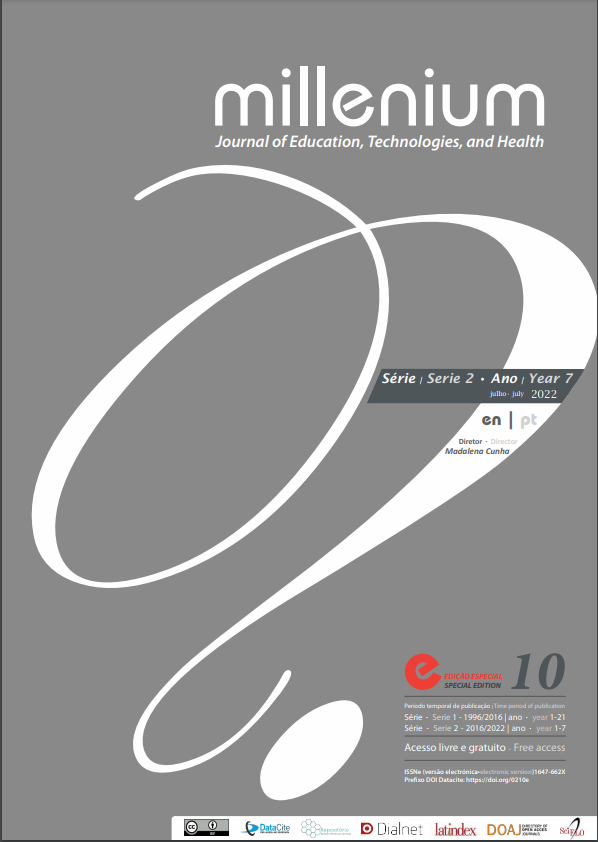Avaliação de impacte ambiental da gestão de resíduos da produção de uma bancada com base na abordagem de ACV
DOI:
https://doi.org/10.29352/mill0210e.25165Palavras-chave:
economia circular, mobiliário, avaliação do ciclo de vida, reciclagemResumo
Introdução: O consumismo tem levado a um aumento dos problemas ambientais e, por isso, as soluções sustentáveis devem ser a prioridade na hora de projetar novos produtos ou serviços. A Avaliação do Ciclo de Vida (ACV) é uma das ferramentas analíticas mais importantes disponíveis para escolher a melhor decisão quando se trata de sustentabilidade.
Objetivo: O foco deste estudo foi aplicar a ACV para a gestão de resíduos resultantes de uma produção de um painel para bancadas de cozinhas e casas de banho. Os cenários de gestão de resíduos estudados foram o aterro (prática atual) e a reciclagem de resíduos. O painel é cnstituído por uma camada de cerâmica sobre um substrato de painel lamelar, formado por glassliner e PVC, que se destina a ser resistente à água, a riscos e a impactos. Os resíduos resultantes da produção do painel são plásticos glassliner e PVC e cerâmica.
Métodos: A metodologia ACV foi seguida e o método EPD 2018 disponível no software SimaPro foi escolhido para quantificar os impactes ambientais da gestão de resíduos. As categorias de impacte ambiental estudadas foram eutrofização, aquecimento global, oxidação fotoquímica, depleção da camada de ozono, depleção abiótica e acidificação.
Resultados: Os resultados mostraram que os dois resíduos plásticos são os principais contribuintes para a acidificação, eutrofização e aquecimento global. No entanto, para a oxidação fotoquímica e escassez de água, o resíduo do componente cerâmico é o principal contribuinte. Comparando os dois cenários, a reciclagem de resíduos diminui todas as categorias de impactes ambientais analisadas em comparação com o aterro.
Conclusão: A reciclagem dos resíduos da produção dos painéis acarreta diminuição nos impactes ambientais em todas as categorias analisadas.
Downloads
Referências
Asokan, P., Osmani, M., & Price, A (2009). Assessing the recycling potential of glass fibre reinforced plastic waste in concrete and cement composites. Journal of Cleaner Production 17, 821–829. https://doi.org/10.1016/j.jclepro.2008.12.004
Benson, C. H., Barlaz, M. A., Lane, D. T., & Rawe, J. M. (2007). Practice review of five bioreactor/recirculation landfills. Waste Management 27(1), 13–29. https://doi.org/10.1016/j.wasman.2006.04.005
Campos, M., Paulon, V., & Filho, J (2013). Resíduos cerâmicos no município de Pedreira [SP]: Equacionamento e soluções de reciclagem Labor E Engenho, 7(1), 74–83. https://doi.org/10.20396/lobore.v7i1.19
Chislock, M. F., Doster, E., Zitomer, R. A., & Wilson, A. E. (2013). Eutrophication: Causes, consequences, and controls in aquatic ecosystems. Nature Education Knowledge 4(4), 10.
https://www.wilsonlab.com/publications/2013_NE_Chislock_et_al.pdf
Geyer, R., Kuczenski, B., Zink, T., & Henderson, A. (2016). Common misconceptions about recycling. Journal of Industrial Ecology 20(5), 1010-1017. https://doi.org/10.1111/jiec.12355
Heijungs, R., Huppes, G., & Guinée, J. B.. (2010). Life cycle assessment and sustainability analysis of products, materials and technologies. Toward a scientific framework for sustainability life cycle analysis. Polymer Degradation and Stability 95(3), 422-428. https://doi.org/10.1016/j.polymdegradstab.2009.11.010
International Organization for Standardization (2006 a). EN ISO 14040:2006. Environmental management – Life cycle assessment – principles and framework. ISO (eds), Geneva, Switzerland.
International Organization for Standardization (2006 b). EN ISO 14044:2006. Environmental management – Life cycle assessment – requirements and guidelines. ISO (eds), Geneva, Switzerland.
Job, S. (2013). Recycling glass fibre reinforced composites – history and progress. Reinforced Plastics 57(5), 19 – 23. https://doi.org/10.1016/S0034-3617(13)70151-6
Kassim, S. M. (2012). The importance of recycling in solid waste management. Macromolecular Symposia 320(1), 43 – 49. https://doi.org/10.1002/masy.201251005
Laurin, L. (2017). Overview of LCA - History, concept, and methodology. Encyclopedia of Sustainable technologies. Elsevier, 217 – 222. https://doi.org/10.1016/B978-0-12-409548-9.10058-2.
PRé Consultant (2020). SimaPro Software, version 9.1. PRé Consultants. https://simapro.com/
Sadat-Shojai, M., & Bakhshandeh, G. (2011). Recycling of PVC wastes. Polymer Degradation and Stability 96, 404 – 415. https://doi.org/10.1016/j.polymdegradstab.2010.12.001
Silva, L., Silva, M., Brás, I., Domingos, I., Wessel, D., & Ferreira, J. (2021). A life cycle assessment study on a new countertop material. Key Engineering Materials 897, 137-142. https://doi.org/10.4028/www.scientific.net/kem.897.137.
Stichnothe, H., & Azapagic, A. (2013). Life cycle assessment of recycling PVC window frames. Resources, Conservation and Recycling 71, 40– 47. https://doi.org/10.1016/j.resconrec.2012.12.005
Downloads
Publicado
Como Citar
Edição
Secção
Licença
Direitos de Autor (c) 2022 Millenium - Journal of Education, Technologies, and Health

Este trabalho encontra-se publicado com a Licença Internacional Creative Commons Atribuição 4.0.
Os autores que submetem propostas para esta revista concordam com os seguintes termos:
a) Os artigos são publicados segundo a licença Licença Creative Commons (CC BY 4.0), conformando regime open-access, sem qualquer custo para o autor ou para o leitor;
b) Os autores conservam os direitos de autor e concedem à revista o direito de primeira publicação, permitindo-se a partilha livre do trabalho, desde que seja corretamente atribuída a autoria e publicação inicial nesta revista.
c) Os autores têm autorização para assumir contratos adicionais separadamente, para distribuição não-exclusiva da versão do trabalho publicada nesta revista (ex.: publicar em repositório institucional ou como capítulo de livro), com reconhecimento de autoria e publicação inicial nesta revista.
d) Os autores têm permissão e são estimulados a publicar e distribuir o seu trabalho online (ex.: em repositórios institucionais ou na sua página pessoal) já que isso pode gerar alterações produtivas, bem como aumentar o impacto e a citação do trabalho publica
Documentos necessários à submissão
Template do artigo (formato editável)





